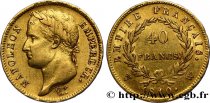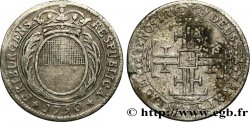bmv_223465 - FRISIA - ANGLO-SAXONS Denier au quatre-feuilles
无库存.
所有在网站上销售的产品 (2012)
价格 : 390.00 €
所有在网站上销售的产品 (2012)
价格 : 390.00 €
种类 Denier au quatre-feuilles
日期: c. 710-750
铸币厂名称/城市 Rhénanie inférieure
材质 silver
直径 12,5 mm
模子方针 12 h.
重量 1,07 g.
稀少度 R3
关于品相的说明
Monnaie sur un flan large, avec un bon centrage des deux côtés, mais légèrement ébréché. Usure homogène et patine sombre dans les creux, mettant en valeur les reliefs
出版目录中的项代码 :
正面
正面的文字 ANÉPIGRAPHE.
正面的说明书 Buste diadémé à gauche avec un nez crochu, le cou perlé ; une croix latine devant le visage et trois globules posés en triangle derrière la nuque.
背面
背面的文字 ANÉPIGRAPHE.
背面的说明书 Quatre-feuilles cantonné de trois globules en triangles.
评论
Malgré les diverses attributions proposées, dans son Numéraire Mérovingien G. Depeyrot ne se prononce pas en mettant les monnaies de ce type dans une série typologique “entrelacs au revers” (cf. pl. 30). Il précise, page 175, que ces “deniers aux entrelacs seraient attribués à Poitiers par d’Amécourt (B. 5995). Pour J. Lafaurie (RN 1996) ces monnaies seraient à attribuer à Maastricht”. P. Grierson et M. Blackburn préfèrent y voir un atelier de la Rhénanie inférieure (p. 508).
La précision selon laquelle pour d'Amécourt “le quatrefeuille doit être attribué à Auxerre et le trèfle à Poitiers” semble assez simpliste (cf. Belfort tome IV, page 281).
Cet exemplaire est d’un style très particulier au droite, avec un nez très crochu, comme sur les B. 5596 et 6698, moins schématique que sur les monnaies rencontrées habituellement.
Despite the various attributions proposed, in his Numéraire Mérovingien G. Depeyrot does not take a position by placing coins of this type in a typological series “interlacing on the reverse” (cf. pl. 30). He specifies, page 175, that these “deniers with interlacing would be attributed to Poitiers by d'Amécourt (B. 5995). For J. Lafaurie (RN 1996) these coins would be attributed to Maastricht”. P. Grierson and M. Blackburn prefer to see a workshop in the Lower Rhineland (p. 508). The clarification according to which for d'Amécourt “the quatrefoil should be attributed to Auxerre and the clover to Poitiers” seems rather simplistic (cf. Belfort volume IV, page 281). This example is of a very particular style on the right, with a very hooked nose, like on B. 5596 and 6698, less schematic than on the coins usually encountered
La précision selon laquelle pour d'Amécourt “le quatrefeuille doit être attribué à Auxerre et le trèfle à Poitiers” semble assez simpliste (cf. Belfort tome IV, page 281).
Cet exemplaire est d’un style très particulier au droite, avec un nez très crochu, comme sur les B. 5596 et 6698, moins schématique que sur les monnaies rencontrées habituellement.
Despite the various attributions proposed, in his Numéraire Mérovingien G. Depeyrot does not take a position by placing coins of this type in a typological series “interlacing on the reverse” (cf. pl. 30). He specifies, page 175, that these “deniers with interlacing would be attributed to Poitiers by d'Amécourt (B. 5995). For J. Lafaurie (RN 1996) these coins would be attributed to Maastricht”. P. Grierson and M. Blackburn prefer to see a workshop in the Lower Rhineland (p. 508). The clarification according to which for d'Amécourt “the quatrefoil should be attributed to Auxerre and the clover to Poitiers” seems rather simplistic (cf. Belfort volume IV, page 281). This example is of a very particular style on the right, with a very hooked nose, like on B. 5596 and 6698, less schematic than on the coins usually encountered








 对产品描述纠错
对产品描述纠错 打印
打印 分享我的选择
分享我的选择 提问
提问 Consign / sell
Consign / sell






